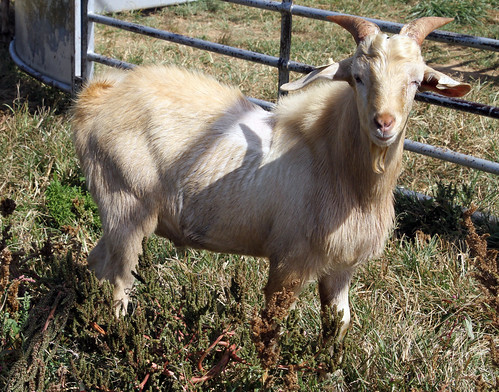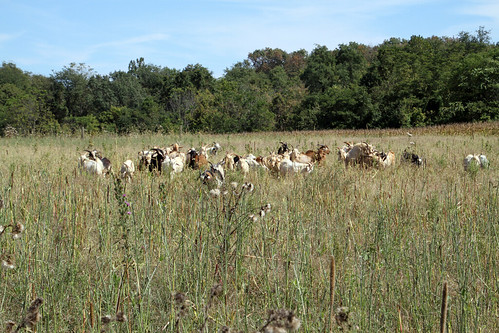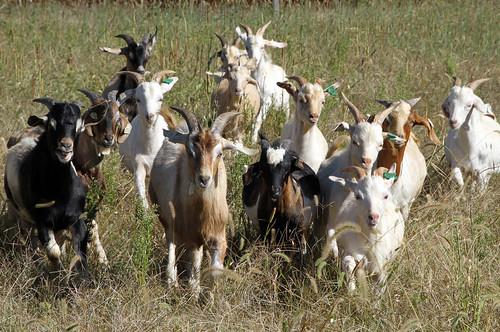-- PRELIMINARY --
The test ended on Friday, October 2. The weather was miserable. After many weeks of little to no precipitation, the conditions were wet and cool. The bucks were weighed two days in a row to get final weights. The final weights are an average of the weights recorded on October 1 and October 2.
FAMACHA© scores, body condition, dag, and fecal consistency scores were determined on October 1. Coat condition could not be evaluated due to the wet weather. A final fecal sample was collected. The Top-10 bucks will not be identified until the final fecal egg counts have been determined and the fecal data has been statistically analyzed.
The goats were also evaluated for reproductive soundness and structural correctness. Scrotal circumference was measured using a scrotal tape measure. Teats were counted and characterized. Bites were checked. Hooves were evaluated for growth and abnormalities. General structure was evaluated. Each buck was assigned a USDA grade.
For the final two weeks of the test, weight gain (loss) ranged from -8.1 to 5.6 lbs. and averaged -0.7 + 3.18 lbs. The standard deviation is very large, indicating a wide variation in weight gain (loss). The median gain (loss) was -0.05 lbs. Average daily gain (ADG) ranged from -0.579 to 0.40 lbs. per day and averaged -0.050 + 0.227 lbs. per day. The median ADG was -0.036 lbs. per day. For the final 14 days of the test, the top-gaining buck was 561 (Pinneo, KS).
For the 84-day duration of the test, ADG ranged from -0.092 to 0.255 lbs. per day and average 0.111 + 0.073 lbs. per day. The median gain was 0.115 lbs. per day. The top-gaining buck was 539 (Majancsik, KY). Other top gainers include 501 (Adams, IL), 543 (Maynard, TN), 551 (Nelson, MD), 568 (Purich, VT), 584 (Weber, IL), 586 (Whelan) and 592 (Wilborn). Each of these bucks averaged over 0.20 lbs. gain per day during the duration of the test.
During the first 42 days of the test ("growth" challenge), ADG ranged from -0.050 to 0.454 lbs. per day and averaged 0.205 + 0.108 lbs. per day. The top-gaining buck was 548 (Murphy, NJ). Forage conditions were considerably better during the first 42 days of the test, as the second half was plagued by dry conditions and the sudden onset of cool, wet conditions at the end of the test.
For the past two weeks, FAMACHA© scores improved from 2.3 to 2.0. The median FAMACHA© score was 2. FAMACHA© scores ranged from 1 to 3. Only 4 goats were dewormed. There was a slight decline in body condition scores. Stools were less soft. Fecal samples could not be obtained from three goats.
USDA grades varied from 1 to 3 and averaged 2.24 + 0.34. The median USDA grade was 2. USDA grades for goats are Selection 1, 2, and 3. They are primarily a muscling score, though condition (external fatness) also has a large effect on grade determination (1=superior muscling, 2=average muscling, 3=thin muscling).
Each goat was mouthed to determine if their (lower) teeth were even with their (upper) dental pad. While several goats had slight underbites, none had unsound mouths. Most of the goats had two normal teats. Only a few teat abnormalities were noted. While opinions differ as to the importance of the number of teats, two sound teats is certainly the preference.
Scrotal circumference (SC) ranged from 20.0 to 29.0 centimeters and averaged 24.8 + 1.7 centimeters. While there aren't specific recommendations for meat goat bucks, a larger scrotal size is generally preferred. In other species, there is a link between scrotal size and ovulation rate in female offspring. Scrotal circumference is affected by age and diet, as well as genetics. 584 (Weber, IL) had the largest testicles in the test.
Hooves were evaluated for growth and abnormalities. A few goats had abnormal heel growth. This appears to be genetic. A numerical score was given to indicate the amount of hoof growth and need for trimming, with 0 meaning no trimming was necessary, whereas higher numbers indicated more growth and the need for hoof trimming.
Only one goat had a structural problem (weak pasterns), but this is not necessarily a functional problem.
Download October 2 (day-84) report
Download Supplemental Data report
The test ended on Friday, October 2. The weather was miserable. After many weeks of little to no precipitation, the conditions were wet and cool. The bucks were weighed two days in a row to get final weights. The final weights are an average of the weights recorded on October 1 and October 2.
FAMACHA© scores, body condition, dag, and fecal consistency scores were determined on October 1. Coat condition could not be evaluated due to the wet weather. A final fecal sample was collected. The Top-10 bucks will not be identified until the final fecal egg counts have been determined and the fecal data has been statistically analyzed.
 |
| One of the top bucks in the test |
The goats were also evaluated for reproductive soundness and structural correctness. Scrotal circumference was measured using a scrotal tape measure. Teats were counted and characterized. Bites were checked. Hooves were evaluated for growth and abnormalities. General structure was evaluated. Each buck was assigned a USDA grade.
For the final two weeks of the test, weight gain (loss) ranged from -8.1 to 5.6 lbs. and averaged -0.7 + 3.18 lbs. The standard deviation is very large, indicating a wide variation in weight gain (loss). The median gain (loss) was -0.05 lbs. Average daily gain (ADG) ranged from -0.579 to 0.40 lbs. per day and averaged -0.050 + 0.227 lbs. per day. The median ADG was -0.036 lbs. per day. For the final 14 days of the test, the top-gaining buck was 561 (Pinneo, KS).
For the 84-day duration of the test, ADG ranged from -0.092 to 0.255 lbs. per day and average 0.111 + 0.073 lbs. per day. The median gain was 0.115 lbs. per day. The top-gaining buck was 539 (Majancsik, KY). Other top gainers include 501 (Adams, IL), 543 (Maynard, TN), 551 (Nelson, MD), 568 (Purich, VT), 584 (Weber, IL), 586 (Whelan) and 592 (Wilborn). Each of these bucks averaged over 0.20 lbs. gain per day during the duration of the test.
 |
| Ample, but poorer quality pasture |
During the first 42 days of the test ("growth" challenge), ADG ranged from -0.050 to 0.454 lbs. per day and averaged 0.205 + 0.108 lbs. per day. The top-gaining buck was 548 (Murphy, NJ). Forage conditions were considerably better during the first 42 days of the test, as the second half was plagued by dry conditions and the sudden onset of cool, wet conditions at the end of the test.
For the past two weeks, FAMACHA© scores improved from 2.3 to 2.0. The median FAMACHA© score was 2. FAMACHA© scores ranged from 1 to 3. Only 4 goats were dewormed. There was a slight decline in body condition scores. Stools were less soft. Fecal samples could not be obtained from three goats.
USDA grades varied from 1 to 3 and averaged 2.24 + 0.34. The median USDA grade was 2. USDA grades for goats are Selection 1, 2, and 3. They are primarily a muscling score, though condition (external fatness) also has a large effect on grade determination (1=superior muscling, 2=average muscling, 3=thin muscling).
 |
| Coming in from the field |
Each goat was mouthed to determine if their (lower) teeth were even with their (upper) dental pad. While several goats had slight underbites, none had unsound mouths. Most of the goats had two normal teats. Only a few teat abnormalities were noted. While opinions differ as to the importance of the number of teats, two sound teats is certainly the preference.
Scrotal circumference (SC) ranged from 20.0 to 29.0 centimeters and averaged 24.8 + 1.7 centimeters. While there aren't specific recommendations for meat goat bucks, a larger scrotal size is generally preferred. In other species, there is a link between scrotal size and ovulation rate in female offspring. Scrotal circumference is affected by age and diet, as well as genetics. 584 (Weber, IL) had the largest testicles in the test.
Hooves were evaluated for growth and abnormalities. A few goats had abnormal heel growth. This appears to be genetic. A numerical score was given to indicate the amount of hoof growth and need for trimming, with 0 meaning no trimming was necessary, whereas higher numbers indicated more growth and the need for hoof trimming.
Only one goat had a structural problem (weak pasterns), but this is not necessarily a functional problem.
Download October 2 (day-84) report
Download Supplemental Data report











